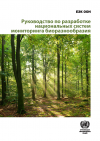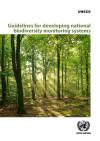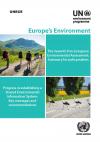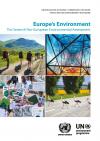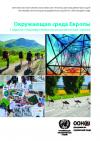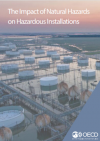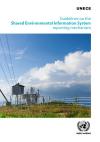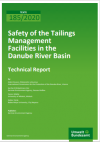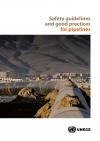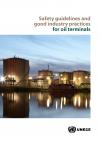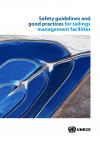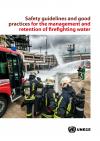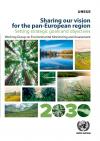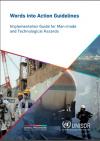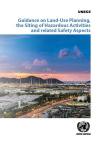Publications
Displaying Results 1 - 20 of 80
- Pусский
In December 2022, at its fifteenth meeting, the Conference of the Parties to the Convention on Biological Diversity adopted the Kunming-Montreal Global Biodiversity Framework
, including a monitoring mechanism.
This guidance on the development of national strategies for the use of biodiversity monitoring helps to make biodiversity
monitoring a practical tool for environmental policy. The
- English
In December 2022, the resumed fifteenth meeting of the Conference of the Parties to the Convention on Biological Diversity adopted the Kunming-Montreal global biodiversity framework, including a monitoring framework.
The present Guidelines for developing national strategies to use biodiversity monitoring help make biodiversity monitoring a practical tool for environmental policy. The guidelines
- English
At the Seventh Environment for Europe Ministerial Conference, held in Nur-Sultan in 2011,Ministers decided to develop the Shared Environmental Information System (SEIS) across the region of the United Nations Economic Commission for Europe (ECE). At the Eighth Conference, in Batumi, Georgia, in 2016, Ministers welcomed progress in developing SEIS to support a regular process of environmental
- Français
Cette évaluation est le fruit de la collaboration entre le secrétariat de la Commission économique des Nations Unies pour l’Europe (CEE) et le Programme des Nations Unies pour l’environnement (PNUE), en coopération avec de nombreuses organisations partenaires et divers experts. Le Groupe de travail de la surveillance et de l’évaluation de l’environnement de la CEE a été chargé de diriger le
- English
The assessment is the result of a collaboration between the secretariat of the United Nations Economic Commission for Europe (ECE) and the United Nations Environment Programme (UNEP), in cooperation with numerous partner organizations and individual experts. The ECE Working Group on Environmental Monitoring and Assessment was tasked with leading the process of consultation on the regular pan-
- Pусский
Оценка является результатом сотрудничества между секретариатом Европейской экономической комиссии ООН (ЕЭК) и Программой ООН по окружающей среде (ЮНЕП) в сотрудничестве с многочисленными партнерскими организациями и отдельными экспертами. Рабочей группе ЕЭК по мониторингу и оценке окружающей среды было поручено возглавить процесс консультаций по регулярной общеевропейской экологической оценке.
- English
Natural Hazards Triggering Technological Disasters (Natech) are becoming a growing concern for the international community and both private and public stakeholders. As climate change persists, extreme weather events such as heavy rains, lightening, floods and heatwaves are projected to be increasingly frequent and destructive, jeopardizing communities, livelihoods and industries. Accidents at
- English
The availability of integrated, relevant, high-quality, timely and easily accessible environmental information provides the means for assessing environmental status and the foundation for meaningful and informed environmental governance. Timely, relevant, reliable and easily accessible environmental information is also essential to efforts to inform citizens about the quality of their environment
- Pусский
Опубликовано: Ноябрь 2020
В целях поддержки компетентных органов и операторов в практической реализации Руководящих принципов и надлежащей практики обеспечения эксплуатационной безопасности хвостохранилищ Агентство по охране окружающей среды Германии (UBA) в 2016 г.
- English
In order to support competent authorities and operators in the practical implementation of the
- English
Parties, beneficiary countries of the Assistance and Cooperation Programme and other countries wishing to implement the UNECE Convention on the Transboundary Effects of Industrial Accidents sometimes face challenges in the interpretation of its provisions. Shedding light on the basic requirements of the Convention, this Guide offers a practical explanation of what compliance with this legal
- English
These safety guidelines and good practices have been developed to support governments, competent authorities and operators in minimizing the risk of fire and safely retaining firefighting water. They are intended to enhance existing practices and promote harmonized safety standards for firefighting water management and retention, in order to prevent accidental pollution of soil and water,
- English
The Joint Expert Group was established in 1998 to work on issues related to the prevention of accidental water pollution, in the context of the Convention on the Protection and Use of Transboundary Watercourses and International Lakes (Water Convention) and the Convention on the Transboundary Effects of Industrial Accidents (Industrial Accidents Convention), both serviced by UNECE. These
- English
This postcard provides a brief summary of the UNECE Safety Guidelines and Good Practices for Pipelines which have been developed by the Joint Expert Group on Water and Industrial Accidents in cooperation with experts on pipelines safety and UNECE. The Guidelines contain key principles and recommendations for the safe transport of hazardous substances by pipelines. They include specific
- English
This postcard provides a brief summary of the UNECE Safety Guidelines and Good Practices for Oil Terminals which have been developed by the Joint Expert Group on Water and Industrial Accidents in cooperation with experts on oil terminals safety and UNECE. The Guidelines provide a set of principles, recommendations and technical recommendations (including for design, planning, procurement,
- English
This postcard provides a brief summary of the UNECE Safety Guidelines and Good Practices for Tailings Management Facilities which have been developed by the Joint Expert Group on Water and Industrial Accidents in cooperation with experts on tailings safety and UNECE. The Guidelines provide a set of principles, technical recommendations and good practices that can assist governments and
- English
This postcard provides a brief summary of the UNECE Safety Guidelines and Good Practices for the Management and Retention of Firefighting Water which have been developed by the Joint Expert Group on Water and Industrial Accidents in cooperation with experts on firefighting water retention and UNECE. The Guidelines aim to support governments, competent authorities and operators by enhancing
- English
The UNECE Working Group on Environmental Monitoring and Assessment has been engaged in efforts to make environmental monitoring an effective instrument in policymaking and, in particular, to assist countries of Eastern and South-Eastern Europe, the Caucasus and Central Asia. UNECE member States, with the support of the secretariat, have made significant progress in establishing the Shared
- English
The guide was prepared in a major inter-agency effort led by the United Nations Office for Disaster Risk Reduction (formerly known as UNISDR), the United Nations Environment Programme (UN Environment) and the United Nations Office for the Coordination of Humanitarian Affairs (OCHA), with a substantive contribution from UNECE and several other key agencies and institutions. The publication was
- English
The Guidance on Land-Use Planning, the Siting of Hazardous Activities and related Safety Aspects has been developed in close cooperation with the constituencies under three legal instruments of the United Nations Economic Commission for Europe (UNECE) – the Convention on the Transboundary Effects of Industrial Accidents (Industrial Accidents Convention), the Convention on Environmental Impact


